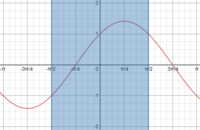Given the function as
z = x cos(a) +y sin(a)
I want to figure out the range value of z represented by x,y like z= [f(x,y),f(x,y)] while given a =[-pi/2,pi/2] . Note that, z only takes real value.
Please give me some hints. Thank you very much. I am very appreciated any helps.
I have tried to transform z to the form: z = R cos(a - b) where tan (b) = y/x. However the values of R and b are dependent so I could not figure out the range for z.
z = x cos(a) +y sin(a)
I want to figure out the range value of z represented by x,y like z= [f(x,y),f(x,y)] while given a =[-pi/2,pi/2] . Note that, z only takes real value.
Please give me some hints. Thank you very much. I am very appreciated any helps.
I have tried to transform z to the form: z = R cos(a - b) where tan (b) = y/x. However the values of R and b are dependent so I could not figure out the range for z.

